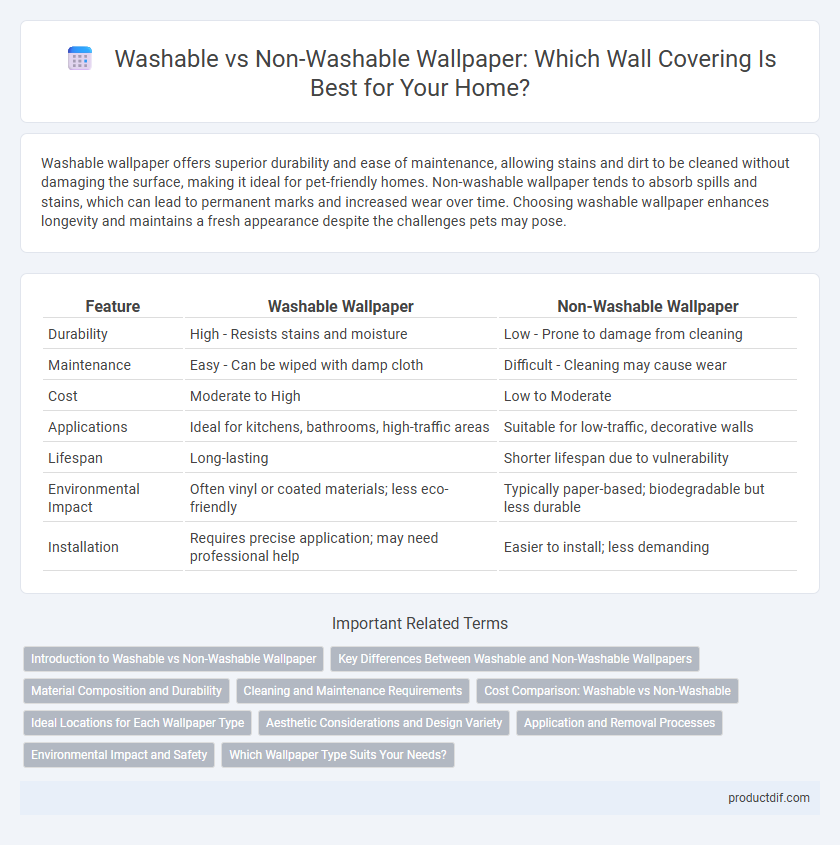Washable wallpaper offers superior durability and ease of maintenance, allowing stains and dirt to be cleaned without damaging the surface, making it ideal for pet-friendly homes. Non-washable wallpaper tends to absorb spills and stains, which can lead to permanent marks and increased wear over time. Choosing washable wallpaper enhances longevity and maintains a fresh appearance despite the challenges pets may pose.
Table of Comparison
| Feature | Washable Wallpaper | Non-Washable Wallpaper |
|---|---|---|
| Durability | High - Resists stains and moisture | Low - Prone to damage from cleaning |
| Maintenance | Easy - Can be wiped with damp cloth | Difficult - Cleaning may cause wear |
| Cost | Moderate to High | Low to Moderate |
| Applications | Ideal for kitchens, bathrooms, high-traffic areas | Suitable for low-traffic, decorative walls |
| Lifespan | Long-lasting | Shorter lifespan due to vulnerability |
| Environmental Impact | Often vinyl or coated materials; less eco-friendly | Typically paper-based; biodegradable but less durable |
| Installation | Requires precise application; may need professional help | Easier to install; less demanding |
Introduction to Washable vs Non-Washable Wallpaper
Washable wallpaper features a durable, moisture-resistant surface that allows for easy cleaning with a damp cloth, making it ideal for high-traffic areas and households with children or pets. Non-washable wallpaper typically consists of delicate materials or finishes that can be damaged by moisture or vigorous cleaning, suitable for low-traffic spaces like bedrooms or formal living rooms. Selecting between washable and non-washable wallpaper depends on the room's function, maintenance preferences, and longevity requirements.
Key Differences Between Washable and Non-Washable Wallpapers
Washable wallpaper is made with durable materials and a protective coating that resists stains, moisture, and dirt, making it ideal for high-traffic or moisture-prone areas. Non-washable wallpaper lacks this resilient surface, making it susceptible to damage when exposed to water or cleaning solutions, and it is best suited for low-traffic spaces. The primary differences lie in maintenance ease, lifespan, and suitability for environments like kitchens or bathrooms where cleaning is frequent.
Material Composition and Durability
Washable wallpaper typically features a vinyl or coated surface that resists moisture, stains, and wear, making it highly durable and easy to clean. In contrast, non-washable wallpaper is often made from paper or fabric materials that absorb moisture and are more susceptible to damage, reducing longevity in high-traffic or damp areas. The material composition directly impacts durability, with washable wallpapers providing superior resistance to scratches, fading, and daily wear.
Cleaning and Maintenance Requirements
Washable wallpaper features a durable, moisture-resistant surface that allows for easy spot cleaning with a damp cloth or mild detergent, making it ideal for high-traffic areas and homes with children or pets. Non-washable wallpaper requires more cautious maintenance, as cleaning can damage the paper's finish, limiting it to gentle dusting or vacuuming to prevent deterioration. Choosing washable wallpaper significantly reduces upkeep time and effort, ensuring long-lasting appearance and hygiene in various environments.
Cost Comparison: Washable vs Non-Washable
Washable wallpaper typically costs 20-40% more than non-washable options due to durable coatings and higher-quality materials. Non-washable wallpaper offers a lower upfront price but may incur additional maintenance or replacement costs over time. Choosing washable wallpaper can lead to long-term savings by reducing the need for frequent touch-ups and replacements in high-traffic or moisture-prone areas.
Ideal Locations for Each Wallpaper Type
Washable wallpaper is ideal for high-traffic areas such as kitchens, bathrooms, and children's rooms where spills and stains are common, allowing for easy cleaning without damage. Non-washable wallpaper suits low-moisture, low-traffic spaces like bedrooms and formal living rooms, where durability against frequent cleaning isn't crucial. Selecting wallpaper based on its washability enhances room longevity and maintains aesthetic integrity amid daily wear.
Aesthetic Considerations and Design Variety
Washable wallpaper offers a broader range of vibrant colors and intricate patterns that maintain their appearance over time, making it ideal for high-traffic areas where aesthetics are crucial. Non-washable wallpaper, while often limited in design complexity, can provide unique textures and finishes that add depth and character to a room. Choosing between washable and non-washable wallpaper depends on balancing design variety with practical maintenance needs in the intended space.
Application and Removal Processes
Washable wallpaper features a durable vinyl or coated top layer that allows for easy cleaning with a damp cloth, making it ideal for high-traffic areas and kitchens, while non-washable wallpaper requires more delicate handling to avoid damage during cleaning. The application process for washable wallpaper often includes a stronger adhesive suitable for moisture resistance, whereas non-washable wallpaper demands careful alignment and smooth surface preparation to prevent tearing. Removal of washable wallpaper typically involves steaming or soaking to soften the adhesive, facilitating easier peeling, whereas non-washable wallpaper may tear easily and usually requires more intensive scraping and solvent use for complete removal.
Environmental Impact and Safety
Washable wallpaper significantly reduces environmental impact by extending product lifespan and minimizing waste through easy cleaning without harsh chemicals, unlike non-washable wallpaper which often requires frequent replacement. The use of eco-friendly, non-toxic coatings in washable wallpaper enhances indoor air quality and safety, preventing exposure to harmful VOCs commonly found in traditional non-washable options. Choosing washable wallpaper supports sustainable practices by decreasing landfill contributions and promoting healthier living environments.
Which Wallpaper Type Suits Your Needs?
Washable wallpaper offers durability and easy maintenance, making it ideal for high-traffic areas or households with children and pets, as it can be cleaned with a damp cloth without damage. Non-washable wallpaper provides a wider variety of textures and finishes, often preferred for low-traffic rooms where aesthetic appeal outweighs practical cleaning needs. Choosing between washable and non-washable wallpaper depends on the room's function and the balance between durability and design preference.
Washable Wallpaper vs Non-Washable Wallpaper Infographic

 productdif.com
productdif.com